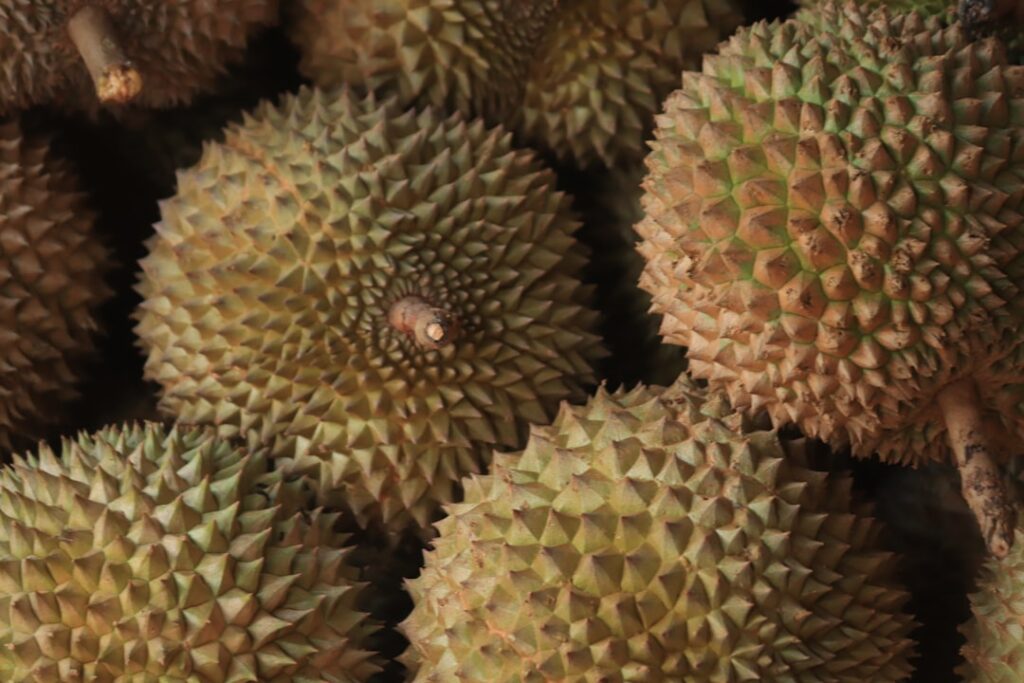What Makes Durian the Most Controversial Fruit in the World
Durian is a large, spiky tropical fruit from Southeast Asia that’s famous for its incredibly strong smell and creamy, custard-like flesh. Known as the “king of fruits,” this polarizing delicacy can weigh up to 3 kg and either delight or disgust anyone who encounters it.
Quick Durian Facts:
- Origin: Native to Borneo and Southeast Asian rainforests
- Size: 1-3 kg weight, up to 30 cm long
- Smell: Contains 44 volatile compounds including sulfur-like ethanethiol
- Taste: Sweet, nutty, custard-like with savory undertones
- Nutrition: High in vitamin C (80% daily value), fiber, and potassium
- Varieties: 30+ species, with popular cultivars like Musang King and D24
As Alfred Russel Wallace wrote in 1856 after his first taste in Borneo: “To eat Durians is a new sensation worth a voyage to the East to experience.” Yet others describe it less kindly – Anthony Bourdain famously compared it to “eating sweet raspberry blancmange in the lavatory.”
This durian guide will help adventurous food lovers understand why this thorny fruit commands such passionate reactions. From its $48,000 auction records to public transport bans across Asia, durian represents one of the most fascinating examples of how culture, biology, and taste intersect in the culinary world.
Whether you’re planning a food tour through Southeast Asia or simply curious about this legendary fruit, understanding durian opens a window into an entirely different approach to flavor and food culture.
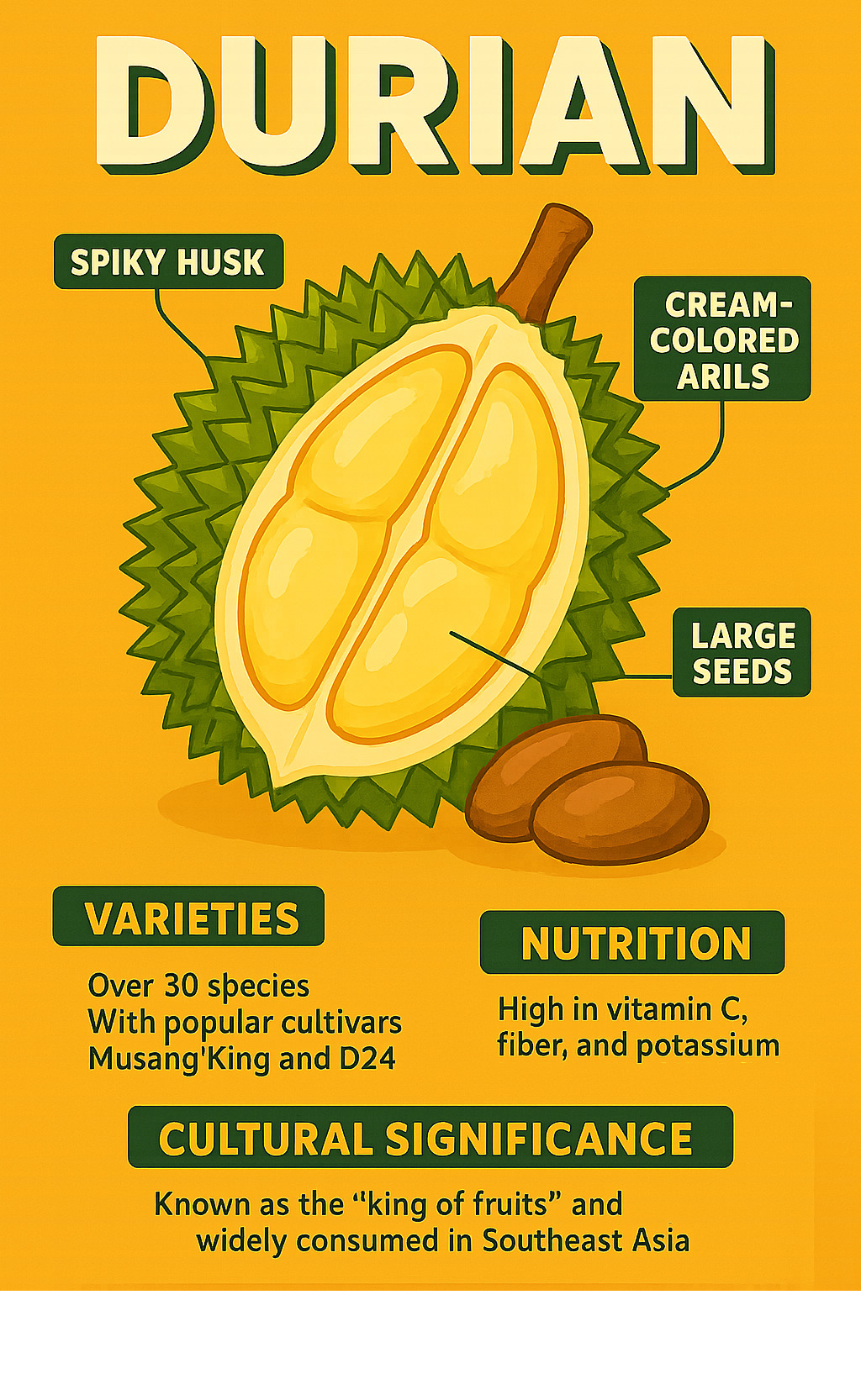
Common durian vocab:
What Is Durian and Why It’s Called the King of Fruits
Meet the durian (Durio zibethinus) – a fruit so extraordinary that it earned the title “king of fruits” through sheer force of personality. This remarkable member of the Malvaceae family calls the lush rainforests of Borneo home, where it has reigned supreme for centuries.
But why the royal nickname? It’s not just the durian’s impressive size or its crown-like spiky armor. This fruit demands the kind of respect usually reserved for royalty – you can’t ignore it, you can’t forget it, and it definitely makes an entrance wherever it goes.
Here’s where things get really interesting: durian trees have struck up one of nature’s most fascinating partnerships. Flying foxes – those impressive fruit bats with wingspans that can reach five feet – serve as the durian’s personal matchmakers. These nocturnal pollinators are actually attracted to that famous durian aroma that sends humans running. Talk about different tastes!
Scientific research on durian genome has uncovered something mind-blowing: durian packs about 46,000 genes into its DNA – nearly twice as many as humans have. Those extra genes include multiple copies of methionine gamma-lyase (MGL), which are the little factories responsible for creating durian’s signature sulfur compounds. Nature really went all-out with this fruit.
Botanical Background of Durian
Durian trees are the skyscrapers of the tropical world, stretching up to 50 meters (160 feet) toward the canopy. These aren’t just tall trees – they’re living monuments that can outlive several human generations.
The durian family is surprisingly large, with 30 different species scattered across Southeast Asia. While nine of these species produce edible fruit, Durio zibethinus remains the superstar of the bunch – the one that makes headlines and breaks hearts (and sometimes noses).
What makes these trees truly special is their patience and their peculiar flowering habits. A durian tree takes its sweet time, waiting 4-5 years before producing its first fruit. When it finally decides to bloom, it does something wonderfully weird: the flowers sprout directly from the trunk and main branches, opening only at night like some kind of botanical vampire. This trunk-flowering phenomenon, called cauliflory, creates a perfect midnight buffet for those flying fox pollinators.
A mature tree’s productivity can vary wildly – from a modest 15 fruits to an impressive 800 per season, depending on the variety and growing conditions.
Etymology and Historical Journey of Durian
The name “durian” comes with zero mystery – it’s refreshingly straightforward. The Malay word “duri” means thorn, add the suffix “-an” to make it a noun, and you’ve got yourself a fruit named exactly what it looks like: the thorny one.
Colonial explorers in the 16th century must have had quite the culture shock when they first encountered durian. Picture these European travelers, expecting familiar tropical fruits, suddenly faced with something that looked like a medieval weapon and smelled like… well, we’ll get to that later.
Alfred Russel Wallace’s 1856 encounter remains one of the most honest and eloquent durian reviews ever written. Despite his initial hesitation about the smell, he finded something remarkable: “the more you eat of it, the less you feel inclined to stop.” That’s the durian magic right there – it grows on you, sometimes literally.
Fast-forward to today, and durian has become a global sensation. Thailand now produces around 700,000 tonnes annually, shipping 400,000 tonnes primarily to China and Hong Kong. What started as a wild rainforest fruit has transformed into a multi-billion-dollar international commodity. From Borneo’s ancient forests to modern supermarket shelves – now that’s what we call a success story.
Appearance, Varieties & How Durian Differs From Jackfruit
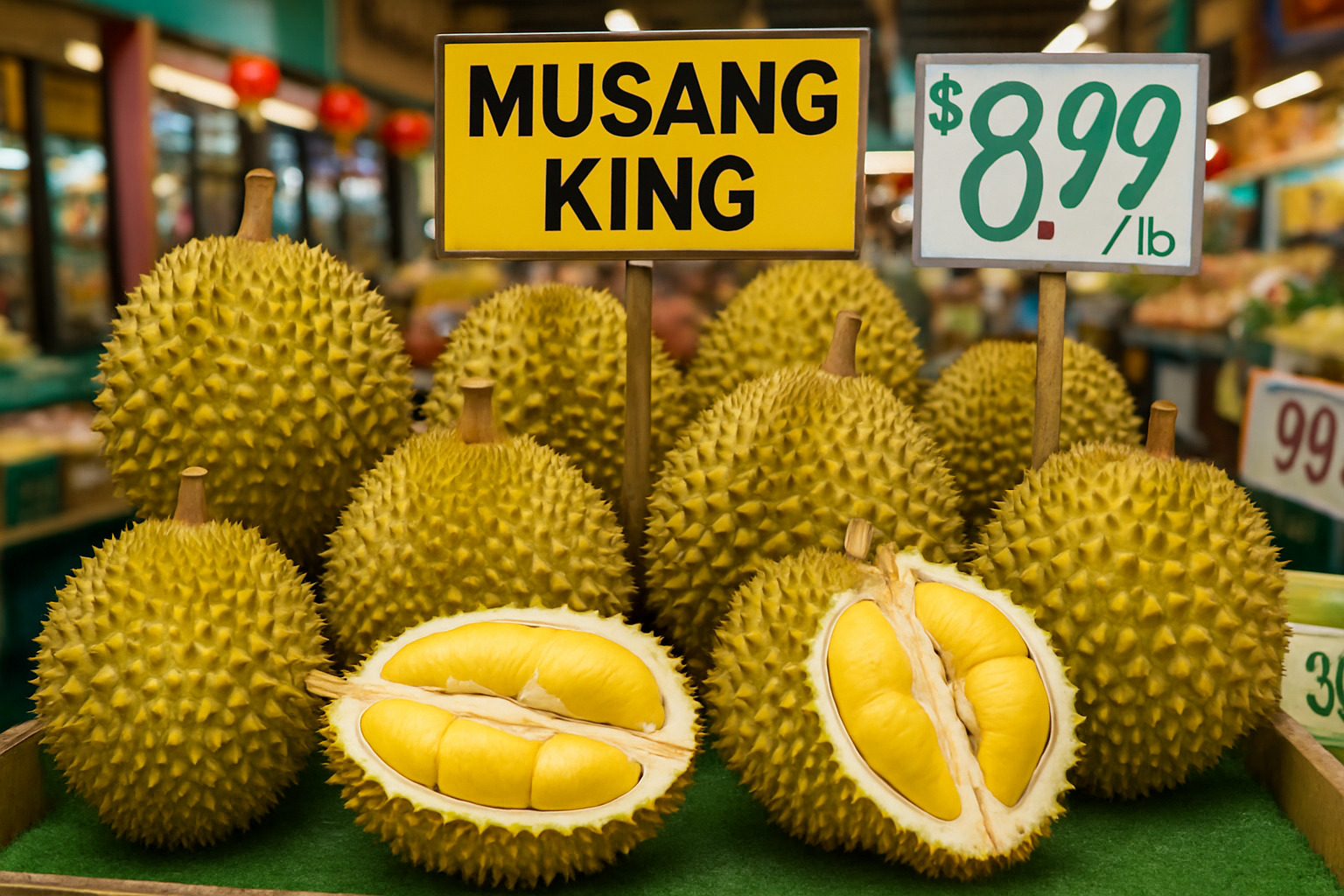
Walking through a Southeast Asian market, you’ll often spot two large, spiky fruits that look remarkably similar at first glance. But don’t be fooled – durian and jackfruit are completely different creatures, each with their own personality and quirks.
The most obvious difference? Those spikes will tell you everything. Durian’s thorns are like nature’s warning system – sharp, dangerous, and absolutely not something you want to grab carelessly. I’ve seen plenty of first-time visitors learn this lesson the hard way! Jackfruit, on the other hand, has softer bumps that won’t send you to the hospital.
| Feature | Durian | Jackfruit |
|---|---|---|
| Spikes | Sharp, dangerous thorns | Softer, less pointed bumps |
| Size | 1-3 kg, up to 30 cm long | Can reach 35 kg, up to 90 cm |
| Smell | Sulfurous, pungent | Sweet, bubble gum-like |
| Flesh | Creamy, custard-like | Fibrous, chewy |
| Seeds | Large, single seed per segment | Multiple small seeds |
| Taste | Complex sweet-savory | Predominantly sweet |
The smell difference is just as dramatic. While jackfruit gives off a sweet, almost bubble gum-like aroma, durian announces itself with that infamous sulfurous punch that either draws you in or sends you running.
Major Durian Varieties (Musang King, Monthong, D24)
The world of durian varieties is like exploring different wine regions – each cultivar has its own devoted following and distinct character. Think of it as the fruit equivalent of fine dining, where connoisseurs can spend hours debating the merits of different types.
Musang King sits at the top of the durian hierarchy like royalty. This Malaysian variety commands respect (and serious money) with its intense, complex flavor that perfectly balances sweetness with a hint of pleasant bitterness. The bright yellow flesh has an almost buttery richness that melts on your tongue. When a single Musang King sold for $48,000 at auction, it proved that some people take their durian very seriously indeed.
Monthong takes a gentler approach. This Thai variety earned its name “golden pillow” for good reason – the pale yellow flesh has an incredibly soft, creamy texture that’s perfect for durian newcomers. Its milder flavor and less intense aroma make it the gateway drug of the durian world. Many Thai exporters prefer Monthong because it travels well and doesn’t overwhelm first-time tasters.
D24 appeals to the sophisticated palate. This variety offers wine-like complexity with layered flavors and a slightly bitter finish that durian enthusiasts absolutely love. It’s the kind of fruit that rewards slow, thoughtful eating rather than quick consumption.
Size, Color and Internal Structure
A typical durian is surprisingly compact for all the fuss it creates. Most fruits measure 14-30 cm long and about 15 cm across, weighing between 1-3 kg. That spiky armor accounts for most of the weight – the actual edible portion represents only 15-30% of what you’re paying for.
Crack open that formidable exterior and you’ll find nature’s clever packaging system. Five distinct chambers house the treasure within, each containing 2-6 cream-colored segments called arils. These arils surround large, chestnut-like seeds that are actually edible too (more on that later).
The flesh itself has a fascinating texture that’s hard to describe until you experience it. There’s a thin, slightly firm outer layer that gives way to an incredibly rich, custard-like interior. It literally melts in your mouth, releasing those complex flavors that make durian such an unforgettable experience.
Durian Flavor, Aroma, Nutrition & Health Insights
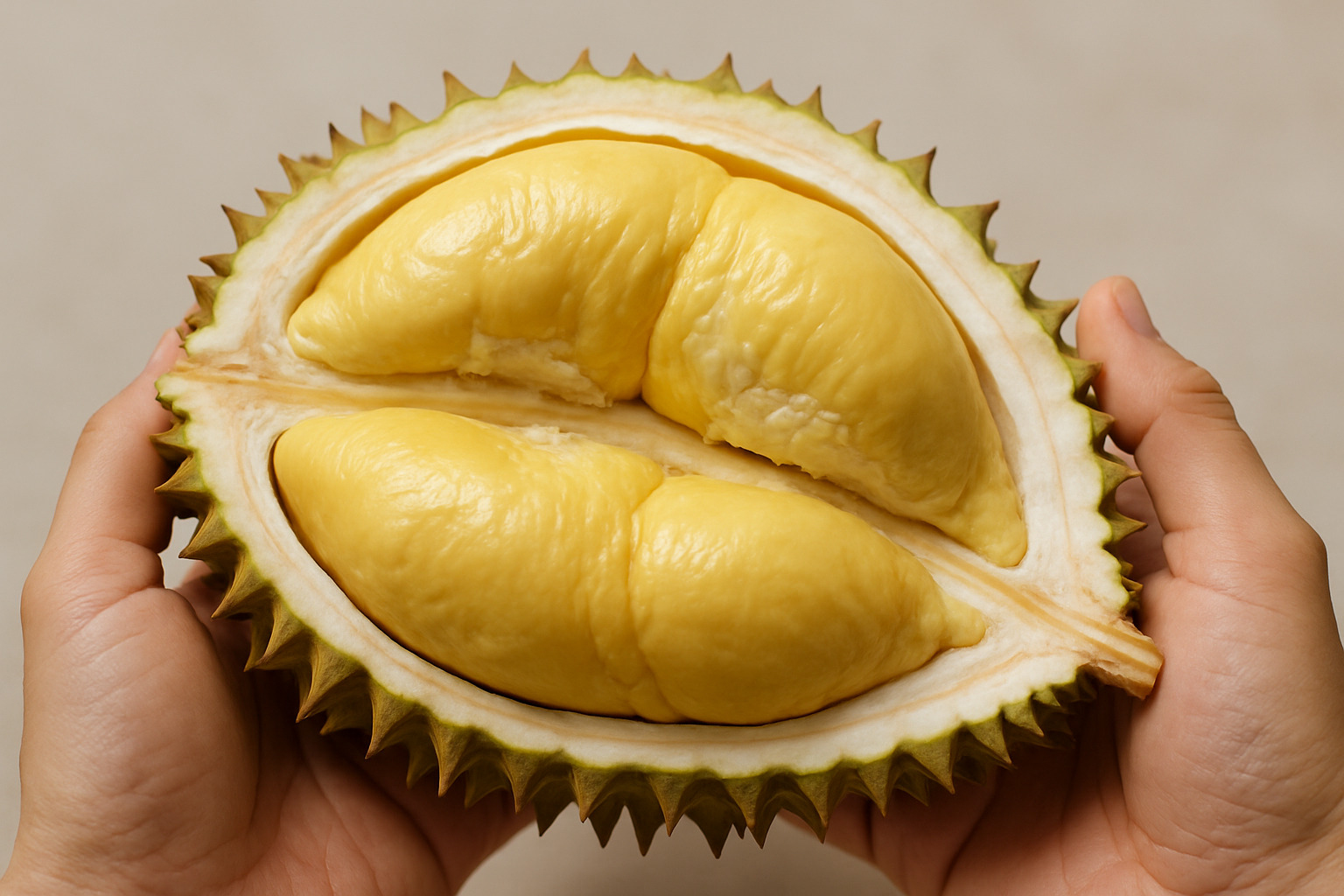
The durian experience is truly one of extremes – what starts as an assault on your nose can transform into a surprisingly delightful taste trip. This remarkable fruit challenges everything we think we know about how smell and taste work together, creating one of nature’s most fascinating culinary paradoxes.
Why Does Durian Smell So Strong?
The mystery behind durian’s legendary stench lies in its incredible chemistry. Scientists have finded 44 different odor compounds working together to create that unforgettable aroma, with ethanethiol leading the charge. If that name sounds familiar, it’s because it’s the same compound that makes rotten eggs smell so awful – and it’s what gas companies add to natural gas so you can detect leaks.
Here’s where it gets really interesting: durian plants have four copies of the genes responsible for producing these sulfur compounds, compared to just one copy in most other plants. It’s like nature decided to turn up the volume to eleven on this particular fruit’s smell.
The aroma is so powerful that it’s earned durian official bans across Southeast Asia. You’ll see “No Durian” signs in Singapore’s subway system, and hotels regularly refuse guests who bring the fruit into their rooms. The smell can linger for days, making it a genuine public concern rather than just a matter of personal preference.
Durian Taste Profile: Custard to Almonds
Despite its challenging introduction, durian’s taste tells a completely different story. The flavor is incredibly complex – imagine a rich custard infused with vanilla and caramel notes, then add hints of roasted almonds and even a touch of savory garlic. Some people detect cheese-like undertones, while others taste tropical sweetness reminiscent of mango or pineapple.
The texture is equally remarkable. That first bite reveals a custard-like creaminess that literally melts on your tongue, coating your palate with rich, almost buttery smoothness. It’s no wonder that many varieties are named after luxurious textures – like Thailand’s “Monthong,” which means “golden pillow.”
Anthony Bourdain captured this contradiction perfectly when he admitted that despite his colorful descriptions of the smell, durian has an oddly addictive quality. The fruit seems to rewire your taste expectations, and many first-time tasters find themselves craving more despite their initial hesitation.
Nutritional Benefits and Potential Health Risks
Durian packs a surprising nutritional punch behind its intimidating exterior. A single cup delivers 80% of your daily vitamin C needs – more than most citrus fruits. You’ll also get substantial amounts of thiamine, manganese, and vitamin B6, plus heart-healthy potassium and fiber for digestive health.
Scientific research on durian nutrition shows the fruit contains powerful antioxidants that may help protect against cellular damage. The monounsaturated fats in durian can actually support heart health by helping to lower bad cholesterol levels.
However, durian comes with some important considerations. At 357 calories per cup, it’s quite calorie-dense, so moderation is key if you’re watching your weight. The high natural sugar content also means people with diabetes should enjoy it carefully.
The most serious concern involves alcohol interaction. Durian contains compounds that may interfere with how your body processes alcohol, potentially causing nausea, vomiting, and heart palpitations. While the combination isn’t necessarily dangerous, it’s definitely unpleasant enough to avoid.
Think of durian as nature’s way of teaching us that first impressions aren’t everything. This thorny fruit proves that some of life’s most rewarding experiences require getting past our initial reactions and embracing something truly unique.
Buying, Opening, Eating & Cooking Durian
Getting your hands on a perfect durian is like hunting for culinary treasure. The whole experience – from selecting the right fruit to safely cracking it open – requires a bit of know-how and definitely some courage. But once you master these skills, you’ll open up a world of incredible flavors.
The key to durian success starts at the market. You’ll want to channel your inner fruit detective here. Look for vendors who know their stuff – they can often tell you exactly when each fruit was harvested and which variety you’re getting.
How to Select and Open Durian Safely
Finding a ripe durian is an art that uses all your senses. Start with the stem test – gently scrape the stem area with your fingernail. If you see bright green underneath, that’s your golden ticket to freshness. A brown or dried-out stem means the fruit has been sitting around too long.
Next comes the weight test. A good durian should feel surprisingly heavy for its size, which means the flesh inside is plump and ready. Give it a gentle press near the base – you want just a tiny bit of give, like pressing a ripe avocado.
Here’s where it gets fun: the sound test. Tap the durian with your knuckles and listen carefully. A hollow sound means the flesh has naturally separated from the shell and is perfectly ripe. If you hear a dull thud, the fruit might need more time or could be past its prime.
Now for the tricky part – opening this spiky fortress safely. Never attempt this without thick gloves. Those thorns aren’t just for show; they can send you to the emergency room faster than you can say “king of fruits.” Get yourself a large, sharp knife and look for the natural seam lines that run from stem to base.
Insert your knife carefully into one of these creases and twist gently. The shell should start to crack open along its natural divisions. Once you’ve got a good split going, use your gloved hands to pry the sections apart and reveal the creamy treasure inside.
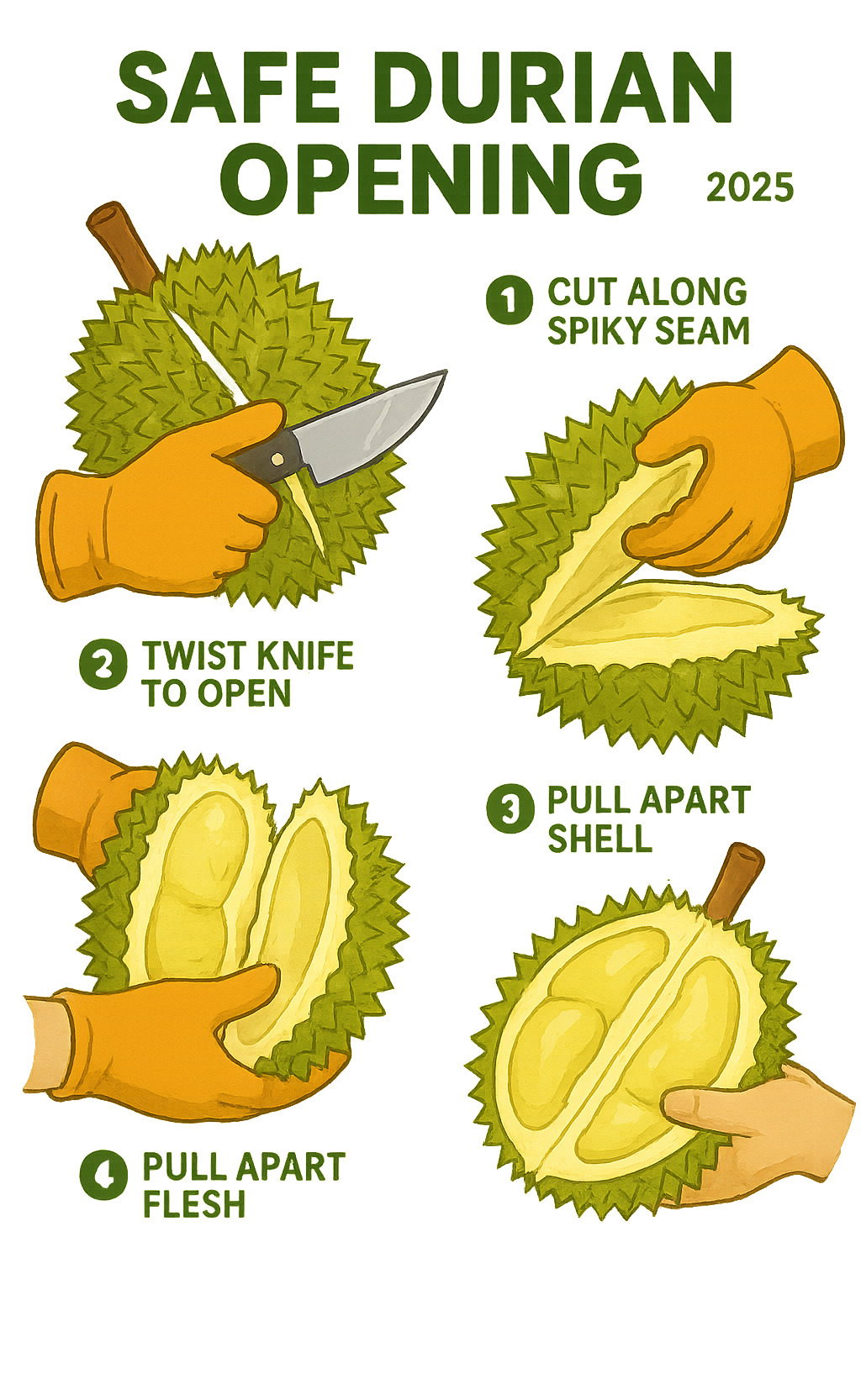
Culinary Uses From Street Snacks to Fine Dining
Durian isn’t just about eating it straight from the shell – though that’s certainly delicious. This versatile fruit has found its way into kitchens across Southeast Asia and beyond, creating some truly amazing dishes.
One of the most beloved preparations is tempoyak, a fermented durian paste that transforms the fruit into something completely different. The fermentation process mellows out the intensity while adding deep, complex flavors that work beautifully in spicy curries and as a condiment.
Street vendors across Thailand serve durian with sticky rice, creating a dessert that perfectly balances the fruit’s richness with creamy coconut milk and chewy rice. It’s comfort food at its finest – sweet, satisfying, and surprisingly addictive.
Modern chefs have gotten creative too. You’ll find durian ice cream in Singapore’s hawker centers, durian pastries in Malaysian bakeries, and even durian crème brûlée in upscale restaurants. The fruit’s custard-like texture makes it perfect for desserts, while its complex flavor profile adds depth to both sweet and savory dishes.
For the adventurous home cook, durian works wonderfully in smoothies (just make sure your blender can handle the intensity), or try incorporating it into homemade ice cream. The key is balancing its strong flavor with complementary ingredients like coconut, vanilla, or even a touch of salt.
Are Durian Seeds Edible?
Here’s something many people don’t know – those big seeds inside your durian are actually edible and quite tasty when prepared properly. But here’s the important part: never eat them raw. Raw durian seeds contain compounds that can make you sick.
The safe way to enjoy durian seeds is to boil them in salted water for about 10-15 minutes, just like you would prepare chestnuts. Once cooked, they have a pleasant nutty flavor and a starchy texture that’s quite satisfying.
Cooked durian seeds are popular as snacks throughout Southeast Asia, and they’re often added to curries for extra protein and substance. They’re surprisingly nutritious too, packed with protein and carbohydrates that make them a valuable part of traditional diets.
So next time you’re enjoying durian, don’t throw away those seeds. With a little cooking, they become another delicious part of this remarkable fruit’s culinary story.
Cultivation, Harvesting and Cultural Significance
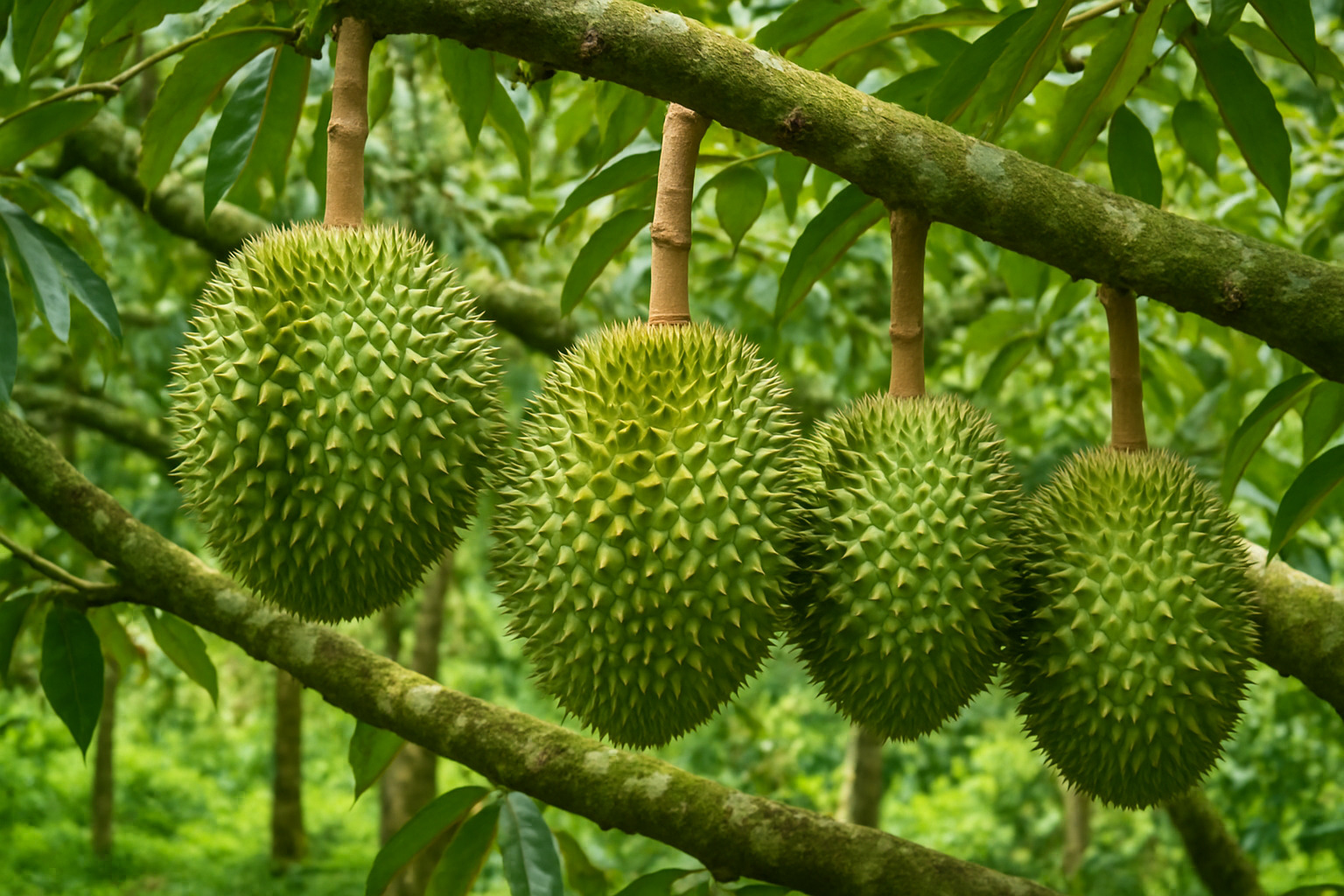
Growing durian is like nurturing a temperamental genius – it demands perfect conditions, endless patience, and a healthy respect for its dangerous potential. This remarkable fruit has shaped entire economies and cultures across Southeast Asia, creating stories that range from heartwarming traditions to hilarious public controversies.
Growing Durian: Climate, Soil, Farming Practices
Durian trees are incredibly picky about their living conditions. They need consistently warm temperatures above 22°C (72°F) and love humidity so much that they practically drink it from the air. These tropical giants also demand well-draining, slightly acidic soil – think of them as the goldilocks of the fruit world, where everything must be just right.
Most commercial durian farms use grafting techniques rather than planting seeds, because growing durian from seed is like playing genetic roulette – you never know what you’ll get. Smart farmers graft superior varieties like Musang King onto hardy rootstock using methods like bud grafting and veneer grafting. This ensures they get the premium fruit that commands top prices.
The trees begin producing fruit after 4-5 years, but here’s where things get dangerous. Harvesting durian is genuinely life-threatening work. These fruits can weigh up to 3 kg and hang 50 meters above the ground on massive trees. Workers must wear hard hats and protective gear because a falling durian can seriously injure or even kill someone.
Traditional farmers often wait for the fruit to fall naturally, but commercial operations use nets or carefully time their harvests to pick fruit just before it drops. It’s a delicate balance between safety and quality.
Durian in Southeast Asian Cultures & Modern Controversies
Durian isn’t just a fruit in Southeast Asia – it’s practically a cultural institution. In Malaysia, people say “durian runtuh” (hit by a durian) when they receive unexpected good fortune, turning the fruit’s dangerous reputation into a symbol of lucky windfalls.
Singapore’s famous Esplanade theater is affectionately nicknamed “The Durian” because its spiky dome architecture mirrors the fruit’s formidable exterior. It’s a perfect example of how durian has become embedded in the region’s identity.
But durian’s cultural impact comes with modern complications. The fruit’s powerful aroma has created a fascinating tension between tradition and urban living. Public transport bans across Southeast Asia highlight how challenging it can be to balance cultural appreciation with public accommodation. Hotels, subways, and airports display “No Durian” signs, and violations can result in hefty fines.
Environmental concerns add another layer of controversy. The explosive growth in durian demand, particularly from China’s booming middle class, has led to deforestation in some areas as farmers clear land for new plantations. This has sparked important conversations about sustainable farming practices and protecting wild durian habitats where flying foxes still pollinate the trees naturally.
Records & Fun Facts About Durian
The most expensive durian ever sold fetched an incredible $48,000 at auction in Thailand. This wasn’t just any durian – it was considered absolutely perfect in every measurable way: size, shape, appearance, and anticipated flavor. That’s more expensive per pound than most luxury cars!
These remarkable trees can live for over 100 years and keep producing fruit throughout their entire lifespan. The tallest recorded durian tree reached 60 meters in height, making it a true forest giant that towers over the tropical canopy.
Here’s a fun space-age fact: Thai researchers actually sent durian samples on unmanned flights to prepare for potential future Thai astronauts who might crave their national fruit while orbiting Earth. Imagine being homesick for durian while floating in zero gravity!
One tropical cyclone was even named Durian in 2006, though fortunately it didn’t smell as strongly as its namesake. The cyclone caused significant damage across Southeast Asia, proving that even weather systems can’t escape this fruit’s notorious reputation.

Frequently Asked Questions about Durian
Is it safe to eat durian with alcohol?
This is one of the most common concerns about durian, and for good reason. While the combination won’t necessarily kill you (despite what some dramatic stories claim), it’s definitely not a pleasant experience you want to have.
Durian contains sulfur compounds that can interfere with how your body processes alcohol. When these two mix in your system, you might experience nausea, vomiting, heart palpitations, and some seriously uncomfortable digestive issues. Think of it as your body’s way of saying “please don’t do this again.”
The reaction varies from person to person – some people might feel fine, while others could end up quite sick. Since there’s no way to predict how you’ll react, it’s simply better to enjoy your durian and your drinks at different times. Your stomach will thank you.
How do I know a durian is ripe without cutting it?
Learning to pick a ripe durian is like developing a superpower – it takes practice, but once you master it, you’ll never be disappointed by an underripe fruit again.
Start with the smell test at the stem end. Gently scratch the stem area and take a sniff. A ripe durian will have a sweet, fragrant aroma even through its thick shell. If it smells sour or has no scent at all, it’s probably not ready.
Next comes the sound test – tap the durian with your knuckles like you’re knocking on a door. A ripe fruit will produce a hollow, resonant sound, while an unripe one sounds dull and solid. This hollow sound means the flesh has started separating from the shell, which is exactly what you want.
Look for natural cracks appearing along the seam lines of the shell. These aren’t damage – they’re nature’s way of telling you the fruit is ready to open. The spikes should feel firm and rigid, not soft or bendy.
Finally, a ripe durian should feel heavy for its size and have just a slight give when you press gently near the stem area. Don’t press too hard though – you don’t want to damage the fruit or hurt yourself on those spikes.
Can I bring durian on airplanes or public transport?
Unfortunately, durian’s incredible aroma makes it persona non grata in most enclosed public spaces. Airlines throughout Southeast Asia and beyond have strict no-durian policies, and they’re not kidding around about enforcement.
Even if you vacuum-seal your durian or wrap it in multiple layers, airport security and airline staff can still detect its presence. The smell has a way of finding its way out, and once it does, you’ll likely be asked to leave your precious fruit behind.
Public transportation systems are equally strict. Singapore’s MRT displays clear “No Durian” signs, and violating this rule can result in hefty fines. Similar bans exist on buses, trains, and subways throughout Malaysia, Thailand, and other Southeast Asian countries.
Many hotels also prohibit durian in guest rooms. The smell can linger for days in air-conditioned spaces, creating problems for future guests and housekeeping staff.
If you absolutely must transport durian, consider shipping frozen durian instead. Many companies specialize in shipping durian internationally using proper packaging and refrigeration. It’s more expensive than carrying it yourself, but it’s often the only way to get your durian fix when traveling.
For the best experience with this amazing fruit, plan to enjoy it fresh at its source during your culinary trips in Southeast Asia.
Conclusion
Your durian journey doesn’t have to end here. This remarkable fruit opens doors to understanding Southeast Asian culture in ways that go far beyond its spiky exterior and notorious smell. Whether you’re already a convert or still working up the courage for that first bite, durian represents something special in food exploration.
Think of durian as your passport to authentic culinary trips. There’s something magical about experiencing this fruit in its native setting – watching vendors expertly crack open the thorny shells at busy night markets, or joining locals who gather around durian stalls with the enthusiasm most people reserve for ice cream shops.
The beauty of durian lies in its ability to surprise you. That intimidating aroma that makes you wrinkle your nose? It’s protecting one of nature’s most complex and rewarding flavors. The key is starting smart – choose milder varieties like Monthong for your first experience, buy from trusted vendors, and remember that even durian lovers needed time to appreciate its unique charms.
What makes durian truly special is how it challenges everything we think we know about fruit. It’s custard and cheese and caramel all at once. It’s banned from hotels but sells for thousands of dollars at auction. It’s both loved and feared, sometimes by the same person on the same day.
For food enthusiasts seeking their next great culinary trip, durian offers something increasingly rare in our connected world – a completely unique experience that can’t be replicated anywhere else. You can’t get the full durian experience from a smoothie or ice cream. You need to be there, in the moment, with the real thing.
If you’re planning culinary travels that push boundaries and create lasting memories, durian deserves a spot on your list. It’s not just about the fruit itself – it’s about joining a conversation that’s been happening across Southeast Asia for centuries. It’s about understanding why something so polarizing can inspire such passion and devotion.
Ready to explore more unique culinary experiences? Check out our More info about culinary tours services to find how The Dining Destination can help you plan unforgettable food trips that go beyond the ordinary.
The world of extraordinary flavors is waiting for those brave enough to accept the unexpected. And few experiences are as memorable – or as rewarding – as the day you finally understand why durian truly is the king of fruits.

